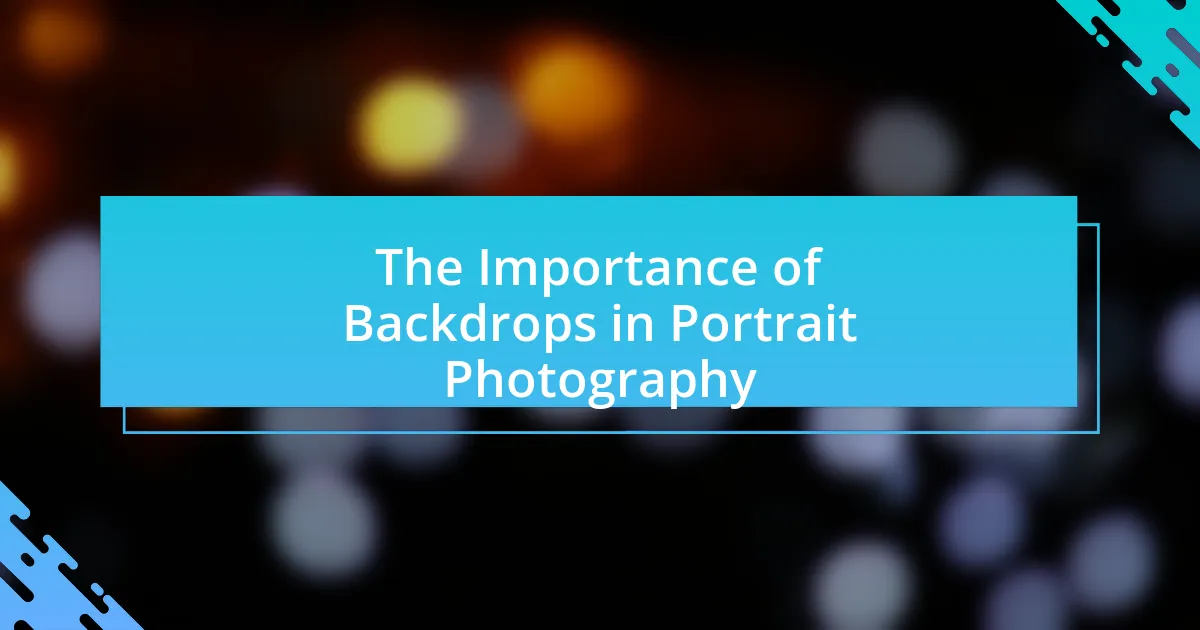Essential lighting equipment for stunning portraits includes softboxes, reflectors, and speedlights, which are crucial for achieving high-quality results. The article explores how lighting impacts portrait photography by influencing mood, depth, and clarity, emphasizing the importance of light quality, direction, and color. It details common lighting setups, the differences between natural and artificial lighting, and best practices for using lighting equipment effectively. Additionally, the article addresses troubleshooting common lighting issues and the role of light meters in achieving proper exposure, providing a comprehensive guide for photographers aiming to enhance their portrait work.

What is Essential Lighting Equipment for Stunning Portraits?
Essential lighting equipment for stunning portraits includes softboxes, reflectors, and speedlights. Softboxes diffuse light, creating a soft and flattering illumination that reduces harsh shadows on the subject’s face. Reflectors bounce light back onto the subject, enhancing highlights and providing a balanced exposure. Speedlights, or external flash units, offer versatility and power, allowing photographers to control lighting in various environments. These tools are widely used by professional photographers to achieve high-quality portrait results, as they enable precise manipulation of light to enhance the subject’s features and overall composition.
How does lighting impact portrait photography?
Lighting significantly impacts portrait photography by influencing the mood, depth, and clarity of the image. Proper lighting can enhance facial features, create shadows that add dimension, and set the overall tone of the portrait. For instance, soft, diffused lighting often results in flattering skin tones and reduces harsh shadows, while dramatic lighting can evoke strong emotions and highlight specific aspects of the subject. Studies in photography emphasize that the direction, quality, and color of light are crucial elements that affect how a portrait is perceived, with natural light often being preferred for its ability to create a more authentic representation.
What are the key elements of effective portrait lighting?
The key elements of effective portrait lighting include the quality, direction, and color of light. Quality refers to whether the light is soft or hard, which affects the shadows and texture on the subject’s face; soft light minimizes harsh shadows, while hard light creates defined shadows. Direction involves the angle from which the light hits the subject, influencing the mood and dimensionality; for instance, front lighting flattens features, while side lighting adds depth. Color temperature impacts the overall tone of the portrait; warmer tones can evoke a sense of intimacy, while cooler tones can create a more dramatic effect. These elements are crucial for achieving a well-balanced and visually appealing portrait.
How does lighting influence mood and emotion in portraits?
Lighting significantly influences mood and emotion in portraits by altering the perception of the subject’s features and the overall atmosphere of the image. For instance, soft, diffused lighting can create a calm and serene mood, while harsh, direct lighting can evoke tension or drama. Studies in photography and psychology indicate that different lighting setups, such as Rembrandt or butterfly lighting, can enhance specific emotional responses by emphasizing shadows and highlights on the subject’s face. This manipulation of light not only shapes the visual aesthetics but also impacts the viewer’s emotional interpretation, reinforcing the idea that lighting is a crucial element in portrait photography.
What types of lighting equipment are essential for portrait photography?
Essential lighting equipment for portrait photography includes softboxes, umbrellas, and reflectors. Softboxes provide diffused light, reducing harsh shadows and creating a flattering look on the subject’s face. Umbrellas, both reflective and shoot-through, help in softening and spreading light effectively. Reflectors bounce light back onto the subject, enhancing highlights and reducing shadows. These tools are widely used by professional photographers to achieve high-quality portraits, as they allow for better control over lighting conditions and contribute to the overall aesthetic of the image.
What are the differences between natural and artificial lighting?
Natural lighting is sunlight that comes from the sun, while artificial lighting is man-made light produced by sources such as bulbs and lamps. Natural lighting varies throughout the day and is influenced by weather conditions, providing a broad spectrum of colors and intensities that can enhance the mood and texture in photography. In contrast, artificial lighting offers consistent control over brightness and color temperature, allowing photographers to create specific effects and maintain uniformity in their work. The differences in color rendering, intensity, and availability make each type of lighting suitable for different artistic purposes, with natural light often praised for its organic quality and artificial light valued for its versatility and reliability.
How do softboxes and umbrellas enhance portrait lighting?
Softboxes and umbrellas enhance portrait lighting by diffusing light, which creates a softer and more flattering illumination on the subject’s face. Softboxes achieve this by enclosing the light source in a fabric that scatters the light evenly, reducing harsh shadows and highlights. Umbrellas, on the other hand, reflect or transmit light through a fabric surface, also softening the light and providing a broad spread. Both tools are essential for achieving professional-quality portraits, as they help to minimize unflattering contrasts and enhance skin tones, resulting in a more appealing overall image.
Why is understanding lighting placement important in portrait photography?
Understanding lighting placement is crucial in portrait photography because it directly influences the subject’s appearance and the overall mood of the image. Proper lighting can enhance facial features, create depth, and eliminate unflattering shadows, which are essential for achieving a professional look. For instance, using a key light positioned at a 45-degree angle can create a natural and flattering illumination on the subject’s face, while fill light can soften harsh shadows. Studies in photography emphasize that effective lighting techniques can significantly improve the aesthetic quality of portraits, making them more engaging and visually appealing.
What are the common lighting setups used in portrait photography?
Common lighting setups used in portrait photography include the Rembrandt lighting, butterfly lighting, loop lighting, and split lighting. Rembrandt lighting creates a triangle of light on the subject’s cheek, achieved by positioning the light at a 45-degree angle to the side of the face. Butterfly lighting, characterized by a shadow under the nose resembling a butterfly, is created by placing the light directly in front and above the subject. Loop lighting involves placing the light slightly to the side and above the subject, producing a small shadow of the nose on the cheek. Split lighting, which divides the face into equal halves of light and shadow, is achieved by positioning the light at a 90-degree angle to the subject. These setups are widely recognized for their effectiveness in enhancing facial features and creating mood in portrait photography.
How does the angle of light affect the subject’s appearance?
The angle of light significantly influences the subject’s appearance by altering shadows, highlights, and overall texture. When light is positioned at a low angle, it creates longer shadows, enhancing facial features and adding depth, which can be flattering in portrait photography. Conversely, when light is directly overhead, it can produce harsh shadows under the eyes and chin, potentially diminishing the subject’s attractiveness. Research indicates that the direction of light can affect perceived skin texture; for instance, side lighting can emphasize imperfections, while front lighting tends to soften them. Therefore, understanding and manipulating the angle of light is crucial for achieving the desired aesthetic in portrait photography.
How can you transition from basic to advanced lighting techniques?
To transition from basic to advanced lighting techniques, one should start by mastering the fundamentals of light, including understanding the properties of natural and artificial light sources. This foundational knowledge allows for the effective manipulation of light through the use of advanced equipment such as softboxes, reflectors, and light modifiers, which can create more dynamic and controlled lighting setups. Additionally, studying lighting patterns and experimenting with different angles and intensities can enhance the ability to achieve desired effects in portrait photography. Engaging with resources like online courses or workshops focused on advanced lighting techniques can further solidify this transition by providing practical experience and expert insights.
What are the best practices for using lighting equipment effectively?
The best practices for using lighting equipment effectively include understanding the three-point lighting technique, adjusting light intensity, and utilizing modifiers. The three-point lighting technique involves using a key light, fill light, and backlight to create depth and dimension in portraits. Adjusting light intensity ensures that subjects are well-lit without harsh shadows, which can be achieved through dimmers or by changing the distance of the light source. Utilizing modifiers, such as softboxes or reflectors, helps diffuse light and soften shadows, enhancing the overall quality of the portrait. These practices are supported by professional photography standards, which emphasize the importance of balanced lighting for achieving visually appealing results.
What specific lighting tools should every portrait photographer have?
Every portrait photographer should have a softbox, a reflector, and a speedlight. A softbox diffuses light, creating soft shadows and flattering skin tones, which is essential for portrait work. Reflectors bounce light back onto the subject, filling in shadows and enhancing the overall lighting. Speedlights provide portable, adjustable lighting options, allowing photographers to control exposure in various environments. These tools are fundamental for achieving professional-quality portraits.
How do reflectors improve lighting in portraits?
Reflectors improve lighting in portraits by bouncing light onto the subject, thereby enhancing illumination and reducing shadows. This technique allows photographers to control the quality and direction of light, creating a more flattering and even exposure on the subject’s face. For instance, using a white reflector can soften harsh sunlight, while a silver reflector can increase brightness and contrast. Studies in photography have shown that proper use of reflectors can significantly enhance the overall quality of portrait images, making them appear more professional and visually appealing.
What role do light meters play in achieving proper exposure?
Light meters are essential tools for achieving proper exposure in photography by measuring the intensity of light in a scene. They provide photographers with precise readings that indicate the optimal aperture, shutter speed, and ISO settings needed to capture an image with balanced highlights and shadows. For instance, a light meter can help determine the correct exposure settings in varying lighting conditions, ensuring that portraits are neither overexposed nor underexposed. This accuracy is crucial, as studies show that proper exposure significantly enhances image quality and detail, making light meters invaluable for photographers aiming for stunning results in their work.
What tips can help you troubleshoot common lighting issues in portraits?
To troubleshoot common lighting issues in portraits, adjust the light source’s position, intensity, and quality. For example, if shadows are too harsh, moving the light closer to the subject or using a diffuser can soften the light. If the subject appears too dark, increasing the light’s intensity or adding a reflector can help illuminate the face. Additionally, if the background is too bright, adjusting the exposure settings on the camera can balance the lighting. These adjustments are essential for achieving well-lit portraits, as proper lighting directly influences the overall quality and mood of the image.

















